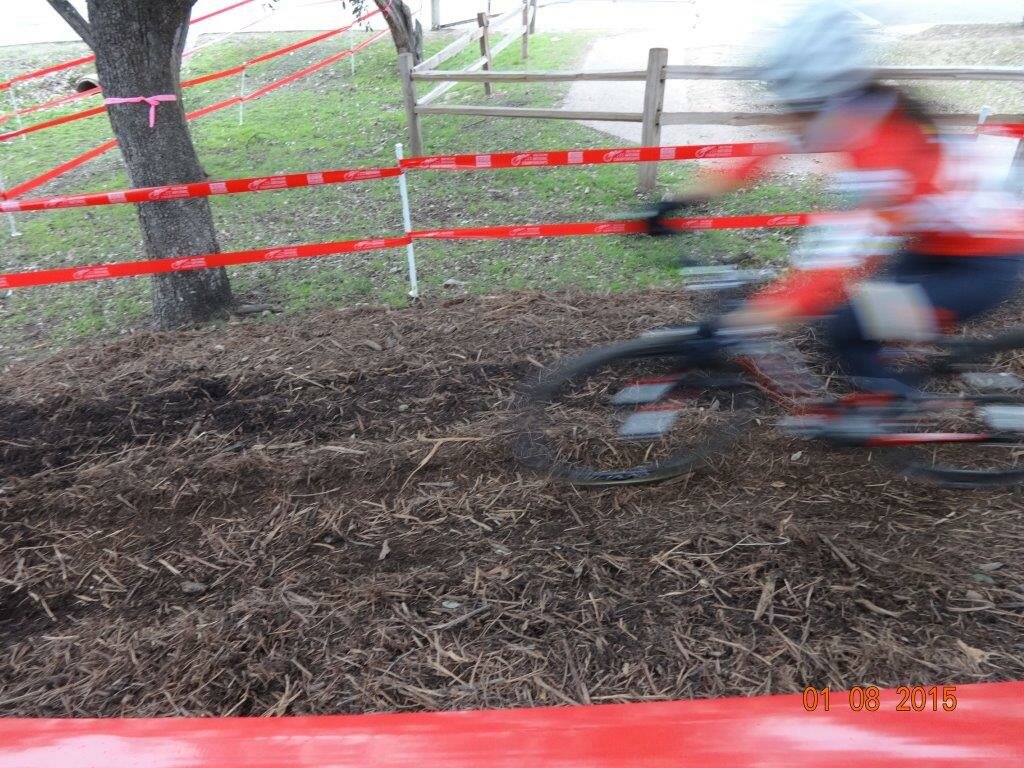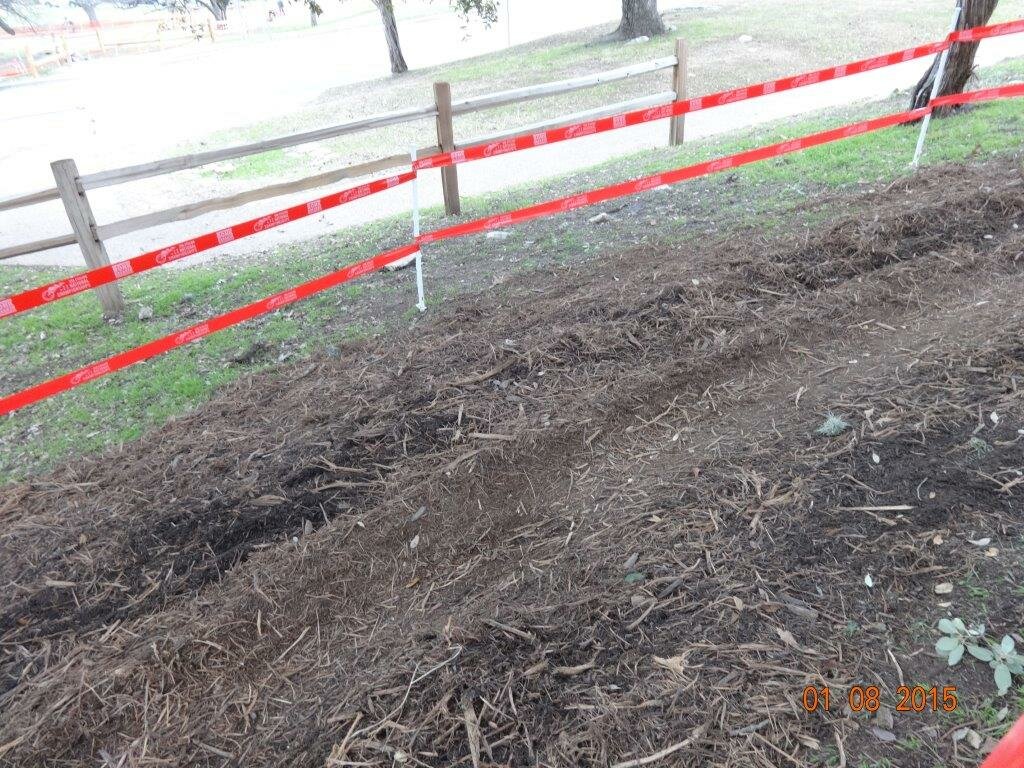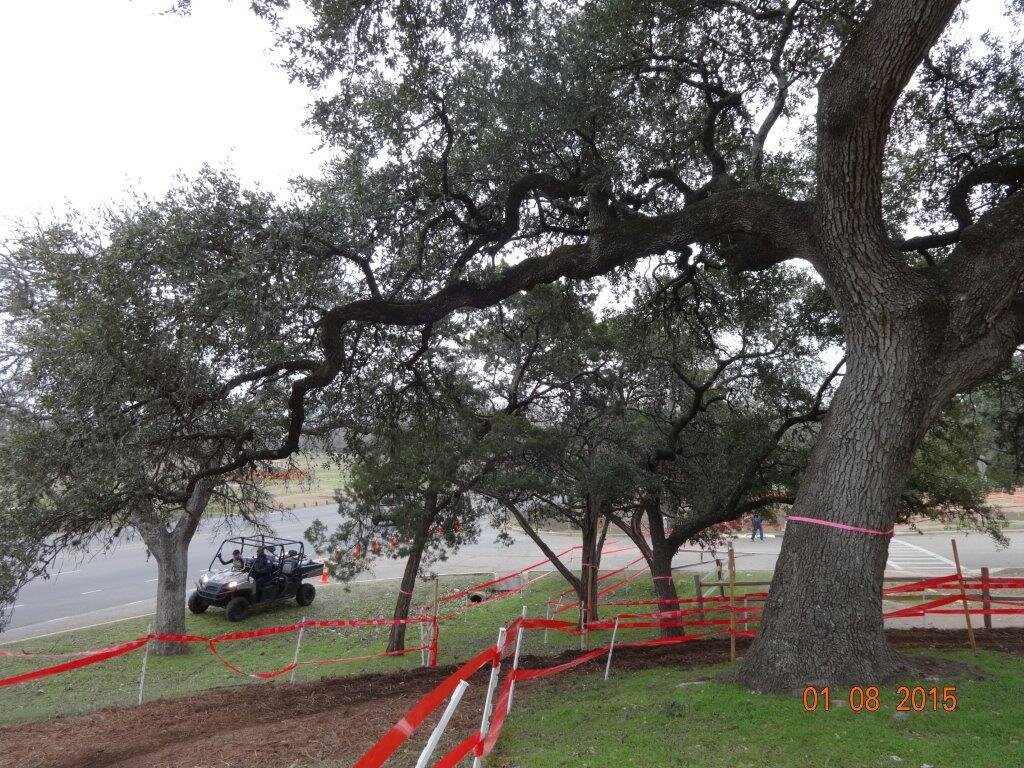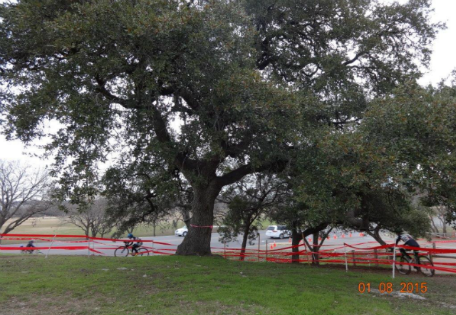Protecting trees
Tree Alerts
911-tree emergencies when trees need your support in the form of
emails or phone calls to council members, boards
and commissions, TXDot and CTRMA officials, etc.
COA Council email addresses:
; ; ;
; ; ;
; ; ;
;
cc: ; ;
;
Only the community can save trees. We can't do it by ourselves. Please, help us save trees. Take action today!
_________________________________________________________________________________________
CYCLO CROSS RACES DAMAGE TREES WHEN THE COURSE IS UNDER THE CANOPIES
Since we are getting nationwide coverage, wherever you live, please, ask your city officials to protect your trees and parks. In Belgium, were this sports originates, they never have these races in parks because of the damage to the grounds and trees. They never have them in sensitive greenbelts either. They go to fields.
It is not OK to damage heritage trees and city parks because it "can all be restored". These races need to be held in adequate locations and not in parks, and the course needs to be out of the full root zones of trees. These races don't need trees but need hills, tough terrain and mud.
Please, see the positive comments we are receiving from cyclists nationwide and Austinites.
RESPONSE TO MICAH RICE'S "What Happened In Austin, A Letter From USA Cycling Events"
Sent To All Race Participants
Micah Rice, Vice-President of National Events for USA Cycling and USA Cyclo Cross Championship race organizer, correctly stated that AHTF had not been involved in the course review and race in this interview by Caley Fretz, 01.13.2015:
"The Heritage Tree Foundation was never present, and it would have been the onus of the
Parks Department to invite them. “We did not know of this tree group,” Micah Rice said."
But in the letter sent recently to all participants to explain what happened, Micah incorrectly claims that AHTF reviewed and walked the course (see text in italics below). We did not. The event organizers met with a grounds staff person from the Parks Department (PARD) and a forester from PARD Forestry.
In spite of having partnered with PARD to actively care for these trees for years (pruning, mulching, and watering), we didn't know until we read a local newspaper article on the third day of the race. The City Arborist also didn't know of this race and had not reviewed or walked the course layout. Tree permits were not obtained.
The course was inside the 1/2 critical root zone of 20 heritage trees, violating City Code. In many cases, the course was 4 ft. from the trunks of very large old trees and in some cases it went 3/4 of a circle around the trees.
This is not about grass that can regrow. This is about a large number of significant 200-300 year old heritage trees that were severely and unnecessarily impacted, and that now need specialized remediation work and supplemental watering and fencing for 1 year.
Austin is about to enter Watering Restrictions Stage 3 Interim due to the drought. Watering outdoor trees will be even more restricted, even when using greywater. These trees should have not been impacted.
The text in italics below is from Micah's letter that can be found at https://www.usacycling.org/what-happened-in-austin-a-letter-from-usa-cycling-events-vp-micah-rice.htm. It is incorrect. AHTF did not review or walk the course, and was not aware of the race:
"Our first interaction with the Heritage Tree Foundation was during the course build out where we
informally walked the course. These course surveys were based more on how to protect the roots
with mulch. Yes, there was talk about critical root zones, but the course was very dry and specific
adjustments were not formally required. However, as we discovered after the amount of precipitation
and subsequent course being compromised with mud, divots, etc., the Austin Heritage Tree Foundation
felt that the course ran too close to the root systems of these trees, threatening the trees’ health.
Unfortunately, during the 36-month preparation for these championships and numerous discussions
with the city, there was never mention of this concern. We performed a course walkthrough several
months out as well as during course construction and we did numerous walkthroughs during the event.
These walkthroughs included Parks staff and their own forestry and tree expert.
We were always told to work with our liaison with Parks and Recreation and we made all changes to
the course based on their recommendations. Had we been asked to make additional changes at any
point, we would have happily routed the course farther away from these root beds and done our part
to stay away from these prized trees.
...When we arrived at the course on Sunday morning for the final day of competition, we started
receiving reports that police were turning riders away around 7:15 a.m. The confusion was
abundant across the board since we had not received any communication from the Parks Department
that they wanted to shut the event down, which was in response to concerns raised by the Austin
Heritage Tree Foundation.
I can assure you that from the moment we first received reports of police turning competitors and
fans away, we began calling and emailing Parks officials. When we did finally reached someone, the
department was adamant about closing the park for 48 hours to allow crews to lay mulch over
exposed root areas and re-assess the course. Obviously such a position was an impossibility in our
eyes because we were adamant that racing had to happen."
PARD Ground staff walked the course daily each morning of the race. We think that they found irrigation pipe exposed on Sunday and shut down the race as is standard PARD practice. The heritage trees had been affected with soil compaction since the first day of the race. The rain on Saturday made the impact on the trees worse, but we think that it was primarily the exposed irrigation that led to the race shut down.
Shutting down the park and event when soils are soggy and irrigation is damaged is what the Parks department is required to do. PARD does NOT allow any event when soils are soggy. This policy should have been discussed with the event organizer.
These races are based on mud. They need mud to make it more challenging. We feel that if it hadn't rained, the organizers would have wetted the course to make it challenging. We think that the event was scheduled intentionally during the time when it typically rains in Austin.
Rain and mud where expected and desired. So, not discussing PARD's policy of closing the park when soils are soggy was a huge mistake...as huge as violating city code and allowing a course in the 1/2 critical root zone of 20 heritage trees.
Micah further claims incorrectly that AHTF walked the revised course and was pleased. We did not meet with the event organizer or participate in any walk-through:
"Sunday afternoon, we did a 90-minute walk-through with the Parks Department and two arborists
from the Austin Heritage Tree Foundation, and all sides were pleased with the changes."
We were not pleased with the course revisions. While the revisions moved the course away from 12 heritage trees, it left the course in the 1/2 critical root zone of 8 heritage trees that continued getting impacted and damaged, much worse due to the very muddy soils.
MICAH RICE RECOGNIZED PREVIOUSLY THAT THEY NEVER MET WITH AHTF
by Caley Fretz, Jan. 13, 2015
"It was possible to protect the trees to the Heritage Foundation’s liking while still holding bike races on
Sunday. So why didn’t that happen?
...USA Cycling and event manager, Cadence Sports, completed the park permit process as instructed.
Potential problems with the trees on course were never brought up with race promoters. The city’s
arborist [correction: former Parks Department Urban Forestry Manager. The City Arborist didn't know
of this race], Angela Hanson, never raised any concerns.
The city never asked USA Cycling or Cadence Sports to apply for a Tree Permit, which lays out the
protection of the city’s Heritage Trees in great detail and would have required that the course met
guidelines laid out by Austin’s Environmental Criteria Manual, which, in the end, it did not.
There were walkthroughs, many of them. The dream course was laid out in June 2014; Cadence Sport’s
Gary Metcalf sat down with Austin Parks and Rec. following a walkthrough. Some changes were made.
The course was first staked out a week out before the event. There was another walkthrough, with
Parks and Rec. staff in tow.
“They had a couple of people involved, I’m not exactly sure who it was, but we know it was someone
from the Parks and there was someone from forestry,” said Micah Rice, USA Cycling’s vice president of
national events. “At that point, they made any decisions to move stuff, manipulate spaces before
the course was built, and the posts went in.”
There was a third walkthrough on Tuesday, again with Parks staff, as well as the city sports
commissioner. Further tweaks were made. “There was some conversation about, ‘Let’s avoid that area,
let’s avoid that tree over there,” Rice said.
There was a walkthrough with Parks staff prior to each day of racing once racing began. The Heritage
Tree Foundation was never present, and it would have been the onus of the Parks Department to
invite them. “We did not know of this tree group,” Rice said. “That group was never presented to us
as a group we were supposed to liaison with. We always understood that if there was a change that
needed to be made, per our permit that we had with the city, that that information would come from
the person we liaison with [at the Parks Department].”
Never was cancelation mentioned. Not once. Not even when USA Cycling staff met with Parks and Rec
staff once again on Saturday night to discuss the effect of the bad weather."
Could the race have avoided tree damage? YES!
"Frustratingly, had Park officials made USA Cycling aware of the potential issues, a simple course
re-route could have prevented the entire polemic. “It appears the city only protects half the Critical
Root Zone, so on a 30-inch diameter tree that is only 15 feet from the trunk, it should have been
easy to do and would have prevented all this mess,” said Brudenell, the Denver arborist. “The Austin
Heritage Tree Foundation wants the full Critical Root Zone protection, but even still, that would be
just 30 feet away from a large 30-inch tree, it could have been done without drastically altering the
course, as I see it.”
COMMENTS FROM CYCLISTS NATIONWIDE AND AUSTINITES
"I just wanted to say as one of the support staff for one of the professional riders that we support your defense of these important heritage trees. We love nature and don't want to do anything to damage these incredible trees. I think there was some misunderstandings on our side and some mistakes that put the trees at risk. It wasn't intentional. I think you'll find many of us who have visited your city are very engaged in preserving our environment in many levels that we both share.
Please don't mistake our frustration at not being able to race today as an attack on your good work. It's easy to misplace anger when emotions run high as you can understand. We would never intentionally destroy trees. They are vital for our life and the health of the local and global health of the world. We will endeavor to preserve the trees and there is an action plan in place to restore the soil and grass. As someone who grew up on a farm the soil's exposure to the air will benefit the solid in multiple ways that will produce good healthy soil and grass. This will benefit the local fauna in the area which only helps the homeostasis of the local environment for all. With respect."
From California: "I am a Certified Arborist who races cyclocross. I totally support what you guys did! I really like your organizations Tree 911 section! Very smart. I race cx out here and help the promoters edit courses when I see tree concerns. I wish someone had done that in regards to Nationals. Anyway, thank you for protecting those trees!
"Certainly grass is a much easier fix than old trees-- but why should we have to fix anything at all when PARD's mission is to maintain it all?"
"Thank you for putting tree protection above any kind of competition that does indeed impact trails, wildlife, plants, and trees. Any wheeled “race” is an inappropriate use of a public park or any natural resource. All bike races should have to prepare an environmental report BEFORE any consideration is given by the public agency that governs the venue. We were sorry that the race or some aspect of it did occur, but we applaud the Parks Dept’s decision to not rush into such competitive races as the damages they do are only too apparent."
From Maine: "I received an e-mail this morning about your courageous stand to protect Austin’s trees. Thank you!! When I come to visit I want to be able to enjoy a landscape that has been carefully and conscientiously stewarded – not thoughtlessly wrecked by people who want to make a jungle-gym out of our natural resources."
From California: "I read an article about the above event being rescheduled and the track moved due to rain and tree roots. I am so pleased to read that some forestry staff take their job seriously and think about mitigating risk for our environment. I realize that the mountain biking lobbyers can be difficult but most of them have very little regard for our planet’s health for the future. I applaud the actions you took and wish that this happened wherever nature has no say as to what trod over it. Just like a child, adults have to stand up and protect nature as we are losing more and more of it due to human interests."
"I have just learned about your organization and was looking up a bit of your history and formation of your group. It does appear that you are very organized and doing amazing work to include educating and protecting the trees. I was hoping to find some information as to how your group started and see if "your model" would be something that we could use. You know it is sometimes effective to "not reinvent the wheel" and if we were able to use you model or any of it then we could be ahead of the game."
"Good work!"
"We do not need resignation from our officials, we need them to be responsible and do their jobs. There is no lack of information here, just an inability to do what has been mandated and what is appropriate for the people of Austin. Our parks are for the peace and recreation of all citizens, not for the events of those who somehow have more privilege.
Leave us our parks and do your promotions and extravaganzas somewhere else. Breaking the law to promote an event is dis-respectful on many levels."
"Thank you so much for the compassion you have for the trees and for bringing your concerns to the attention of others. These things needed to be said. The situation needed to broadcast to the community. Thank you for being a vocal part of the controversy."
"I thought of you as I drove home past Zilker Park this afternoon. I saw the "trails" and thought, how could this have happened? Thanks for speaking out & for documenting the damage with photos. I agree, this event is TOTALLY inappropriate for Zilker Park and its heritage trees."Please help the 20 Zilker heritage trees impacted by the USA cyclo cross bike championship
(Posted 01.10.15)
This Sunday 101.11.2015 and this coming week, please contact the Parks Department (; ; ; ; ), the City Manager's office (; ), the City Arborist (, ), and our new city Council (see above).
Ask them to:
• Never allow competition events like this under the trees canopies
• To cancel the racing event on Sunday 01.11.15 if the soils become too soggy
• For the Parks Department to mitigate the soil compaction with adequate soil aerations as described below.
The soil damage in the 1/2 Critical Root zone of the trees needs to be repaired by performing a soil aeration with an air spade, 8 inches deep, with incorporation of organic matter (not dillo dirt) and topped with no more than 3-4 inches of mulch, followed by adequate watering and fencing of the aerated area for 1 year so that the roots can grow again.
The USA Cyclo cross championship race is totally inappropriate for Zilker Park, the jewel of Austin, and should have never been allowed. Participants pick up their registrations packages at Hill Abell's Bicycle Shop. The Walnut Creek Metro park has many cross country trails where this race could have been held.
At least 20 healthy heritage trees have been impacted by the excessive soil compaction in the 1/2 Critical Root Zone, an area protected by City Code, caused by the 1,800 bike riders doing laps around the track.
The track is placed under the canopies of dozens on 200-300 year old heritage trees intentionally to provide thrills to the participants. The track is very close, about 4 ft., to the trunks in many areas. Races start every hour and consist of 60-80 riders released at once to do as many laps as possible for about 1 hr.
The pictures below show the damage to the tree root zones as of Thursday afternoon, before the faster races and the rain. The younger riders scheduled for Friday and Saturday, and the elite riders scheduled for Sunday will cause much more impact to the soil since they are stronger and will make more laps.
This unnecessary and senseless damage to these heritage trees is criminal. The Parks Department has handled this event very disgracefully. They are charged with protecting these irreplaceable heritage trees that belong to the community.
Only one person from City staff, a Parks Department forester, reviewed and approved these plans, and allowed for the track to be located under the heritage trees violating City code. The Parks Department took care of protecting their facilities but not the trees. They kept the track away from the area behind the Zilker Theater to avoid impacting the irrigation that was installed in 2010, but the heritage trees were not protected.
The Parks Department needs to cancel the competition if it rains enough for the grounds to become soggy because the impact to the soil will be exponentially worse since soggy soils compact much more. The Parks Department knows the problem with soggy soils and has backup plans for the parking areas, to protect the grounds and grass that they replanted recently, but they have no plans to protect the heritage trees effectively.
Mulch will only help slightly since the bike tires will push it away as show in the pictures below The race participants like to ride their bikes in mud, that is part of the thrills.
The Parks Department plans to restore the grounds by adding top soil and grass seed, and monitoring the grounds in Spring. This will not help the heritage trees at all and it will hide the problem.
The soil damage in the 1/2 Critical Root zone of the trees needs to be repaired by performing a soil aeration with an air spade, 8 inches deep, with incorporation of organic matter (not dillo dirt) and topped with no more than 3-4 inches of mulch, followed by adequate watering and fencing of the aerated area for 1 year so that the roots can grow again.
City code protects heritage trees from this type of impact on the 1/2 Critical Root Zone (an area between the trunk and half way from the trunk to the edge of the canopy) because compacted soil makes it very hard for roots to grow and for water to penetrate the soil.
Many more heritage trees have been impacted by the participants riding their bikes on the full critical root zone, an area that City code fails to protect but that nationwide Best Management Practices recommend be protected for heritage trees.
The damage to the heritage trees root zones may not be repairable. Remediation for soil compaction and tree root impact is involved and expensive, and may not work if the process is not implemented correctly by an experienced certified arborist. Soil compaction should be avoided and not looked at something that can be easily mitigated.
It is not as simple as re-leveling soil and planting new grass. If the impact to the trees is not corrected adequately, these trees will decline in a few years and the Parks Department will target them as dangerous and remove them.
The Parks Department has asked the event organizer to add mulch to some areas but this will not help much since the riders compact the mulch and push it out of the way. See pictures below showing this. This is the only heritage tree that had mulch by Thursday afternoon.


This tree is a healthy 300 year old live oak heritage tree that is magnificent, of good shape and worthy of preservation but that has now been impacted by the participants riding their bikes under the tree's canopy. This is a public tree that belongs to the community that has been damaged to cater to an event.


The pictures below show surface roots that were broken by the riders, and riders driving over the broken roots. They also show roots that originally were buried below the surface but are now exposed due to the riders impacting and removing the soil. But the worse damage is the one that can't be seen, the soil compaction below grade where roots need loose soil to grow.
